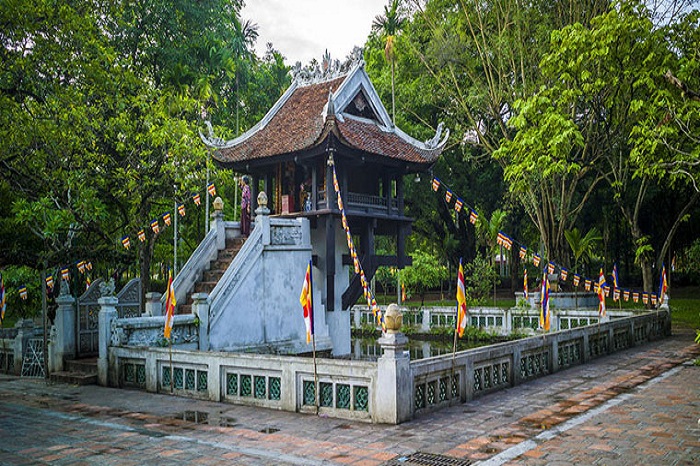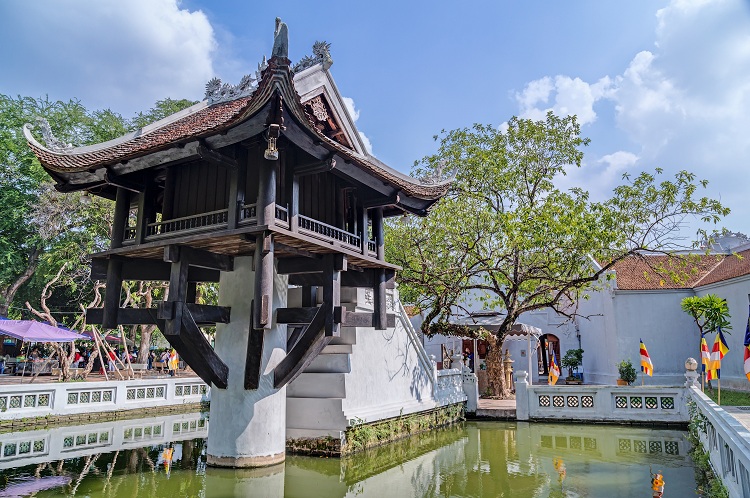
The One Pillar Pagoda, a legendary symbol of Hanoi
- on Jul 23, 2020 By: Ngoc Nguyen
Hanoi is known for its multiple temples and pagodas. Among all these places of worship, the One Pillar Pagoda or "Chua Mot Cot" in Vietnamese is a must-see in Hanoi and another emblem of the Vietnamese capital. Truly a unique architectural work in South East Asia as well as in Vietnam.
History of the One Pillar Pagoda
Like many places of worship in Vietnam, the One Pillar Pagoda was linked to a legend. This dates back to the 11th century when Emperor Ly Thai Tong, the second representative of the Ly dynasty who reigned from 1028 to 1054, ordered the construction of a lotus-shaped pagoda. Influenced by having had a son following a dream during from which the goddess of mercy (Quan Am) seated on a lotus in the middle of a lake held out an infant to her. According to a 12th-century stele, "in the middle of Linh Chieu Lake, a stone column was erected supporting a lotus with 1000 petals which rests on a red pagoda". Every lunar month, on the 1st and 15th day, he went to meditate there. In the pagoda, there is an altar dedicated to the goddess Quan Am.

The pagoda was rebuilt in the 13th century by the Tran dynasty and then restored by the Nguyen dynasty. It then survived the years without much damage until 1954 when it was partially destroyed by the French before President Ho Chi Minh had it rebuilt in 1959.
This thousand-year-old pagoda was classified as a historical monument in 1962 and entered the Guinness Book of Vietnam in 2006 to salute its originality before being included in the Guinness Book of Asia in 2012. To celebrate Hanoi's millennium in 2010, restoration work was carried out to revive its iconic site dear to the hearts of the Vietnamese. This place of worship located in beautiful greenery is always frequented by couples wishing to have children. Inside the pagoda is an altar where women come to pray and make offerings to solicit fertility. Vietnamese also go there on Tet, the Vietnamese Lunar New Year, to pray and ask for happiness, success and luck.

Its unique architecture
Despite a tumultuous history, the pagoda has kept its original architecture although the single wooden pillar was replaced by a concrete pillar. The unique architecture of the pagoda combined several symbolic repertoires. If Buddhism is most evident with the lotus flower which symbolizes enlightenment, we also find the symbol of fertility with the stone pillar through which the vital energy passes between land and water. The red flag represents perfect bliss. We also appreciate its magnificent curved roof, covered with tiles at the top of which we can see dragons.
The pagoda is placed in the middle of a body of water, symbolizing a lotus flower floating lightly on a pond. A poetic vision instilled by Emperor Ly Thai Tong. In front of the pagoda, you will notice a Bodhi tree donated in 1958 by the President of India to President Ho Chi Minh. This tree occupies a particularly important place in Buddhist mythology since it is under this tree that the Buddha, after having meditated for a long time, attained enlightenment. The One Pillar Pagoda is located in a pleasant environment, surrounded by gardens, it is a real breath of fresh air during your visit to the Vietnamese capital, especially in spring when the trees are in bloom and distil their sweet scents.
The lotus flower

A symbolic flower of Vietnam, the lotus flower is intimately attached to the image of Buddha and is associated with purity, spirituality and beauty. A flower that holds a very important place in Vietnamese culture and that can be found in many representations.
The famous Ba Dinh square
The One Pillar Pagoda is located behind the Ho Chi Minh Museum, the nation's all-time venerable father, and the famous Ba Dinh Square. Ba Dinh Square holds a very important part in Vietnamese history as for centuries, it was the symbol of power. All around you can observe a large number of ancient colonial buildings including the former palace of the Governor General of Indochina which is now the presidential palace. Ba Dinh Square is best known for being the place where Ho Chi Minh read the Independence Proclamation of the Democratic Republic of Vietnam on September 2, 1945. Moreover, President Ho Chi Minh is buried in the mausoleum located on this square. In the evening, many Hanoians come with their families to relax on the lawns of this immense square.
Related articles:
>> The train street in Hanoi, an unparalleled ride
Comment
Other Blog
Categories
Latest News
on 31 Dec, 2025
on 31 Dec, 2025
 Español
Español Français
Français




















Morgane Ter Cock
on Dec 18, 2025HerbertPhomaMS
on Oct 19, 2025Lilyan Cuttler
on Oct 15, 2025Avenue17XC
on Sep 14, 2025Avenue18JL
on Jul 21, 2025